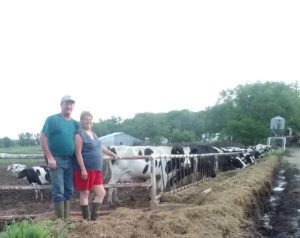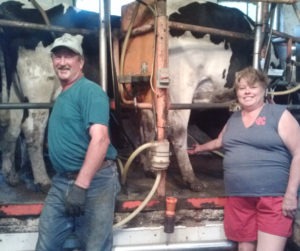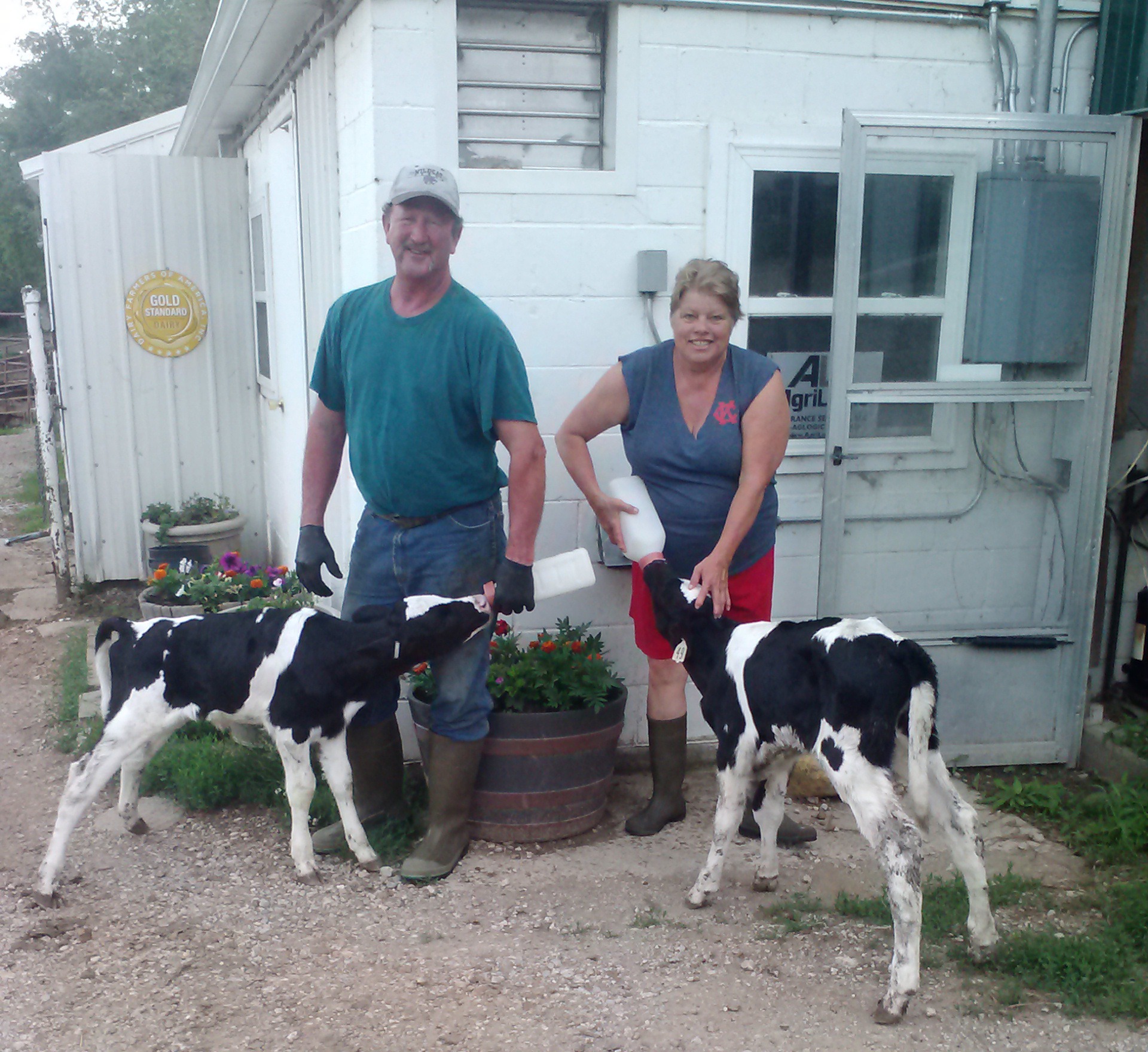She is no fool.
Never has been; through thick, thin, ups, downs, children, fire, just about name it, whatever, where there’s a desire, there’s a way.
Really much more complicated, but most simply, she just plain “loves to milk” cows.
“Your heart has to be in it. I’ve been the full circle. I’m a survivor. Those cows depend on us, and we depend on them. And now, it’s paying off with the highest milk prices ever,” Kathy Barr hurried the ‘visit at work’ to conclusion.
“I have to get home to milk,” she insisted with no grudge, but ample enthusiasm.
An insurance agent now by workingclass hours, Barr is a dairywoman at heart by life. Husband Jim and families of their grown sons, Brandon and Kyle, who have four children, are all intimately involved in the close knit dairy operation. Without dispute, it’s a contagious and heritable “love for the cows.”
Day was every farmer had a Bossy for family use, with majority of farms always milking a few cows for cash income, and dairies were a notable part of every county’s agriculture revenue. Now, dairy production in Kansas is at an all-time high, as cow inventory approaches records, too, despite the number of dairies being the lowest ever.
Several in western Kansas, big operations with lots of high producing cows sometimes milking day-around in three shifts account for the state’s vast milk gallon tally today. Many counties have no dairies.
Neighboring Lyon County has none, initial thinking was Osage County had two, come to figure, there’s only one. It’s the Barr Dairy, although with a mailing address of Lebo in Coffey County, which records two operating dairy farms.

“We are not quitting,” Kathy Barr emphatically evaluated her seemingly eternal outlook on the profession.
“I started in the dairy business on April 1, it was April Fool’s Day, 1978. Some people may have thought I was foolish. But, Jim worked in town, and we had a six-month-old baby. I needed to take care of our first son, Brandon, and have a job, too,” clarified Kathy on the verge of being blunt.
“I had been milking cows twice a day ever since I was in the eighth grade at home growing up. We purchased the dairy years later and have been milking straight through. It has been a good way to make a living,” Barr declared.
Plainly, lots of very hard work, before sunrise in the morning to after dark at night, dedicated family effort with never remorse, but pleasure of success, growth and even a bit of financial security through every threatening slump.
“I started with 17 cows, and no equipment, other than Jezebel the blue Dodge pickup with no starter, one door. I had to roll Jezzie downhill so she’d turn over, then I’d jump in and haul hay to the cows,” reflected Barr, now with a sparkle of those “good ole days.”
Three milking machines were added, then things really started improving when the Barr Dairy added a bicycle-front-wheeled M crank-start tractor to handle feed hauling chores. “I was coming up in the dairy business,” admitted Barr, who originally did most of the milking, chores and farming.
“Jim had a job, and initially really didn’t know anything about the dairy business. He helped certainly, but I was the dairy woman. It was hard for feed salesmen, and the like, to understand that. They’d always want to know if my husband was around to talk about the farm operations, but eventually they understood I was the one who handled the dairy,” Barr substantiated.
Starting on 98 acres, the grade-A Barr Dairy is up to 240 acres now. “We produce our own green chop, silage actually, but we’ve always bought all of our alfalfa, prairie hay and grain,” the milkmaid said.
“Joe Isch of Wildcat Feeds creates our total mix rations (TMR), which are always changing with the quality of hay. Jim now does all of the feeding, and ordering of the feed that is delivered right to our upright storage bins,” Barr commented.
With a second son, Kyle, on the scene, Barr Dairy expanded, too. “We got more cows, and Jim also started milking. His cows were milked in the ground level stanchions, and I had my cows in the upper level three-herringbone. We ran a $1,000 milk pipeline, and were concerned the vacuum system wouldn’t pull the milk up from Jim’s cows to the storage tank, but it did,” Barr explained.
Noteworthy, the cows remained “His” and “Hers,” because the cows got into their own barn position and routine, so they couldn’t readily be switched back and forth between milking environments.

“We now have a double-three herringbone grade-A milk parlor and an auger feed system, but no feeding is done in the barn,” Barr explained.
Presently, the Barr Dairy herd numbers more than 70 head of Holsteins, with 62 lactating cows today.
It’s a fulltime job, but like with so many farm families today, so sadly the majority, making a living in agriculture is tough. “No matter how hard we worked, and successful we were, we still couldn’t make ends meet. But, I still wanted to milk cows, and Jim had become addicted with a love for dairying, too,” Barr said.
So, to make it all possible, Kathy Barr is now an insurance agent at Trust Point Insurance in Burlington for off-farm income, and Jim stays at the farm to be in charge of milking the cows.
No, that’s a misnomer; Jim is at the dairy during the day, but Kathy is still there morning and night, typically hands on cows and milkers, too.
“It’s 25 minutes from home to the office, so it’s really not that hard. I have lots of appointments with farmers and homeowners in their homes, and have even done business in my dairy barn,” insisted the forever-optimistic dairywoman-insurance agent-agriculture leader.
Brandon and Kyle grew up milking cows, active in 4-H and FFA project work, successfully showing homeraised cows and collecting judging and other club work honors as Kathy and Jim were dedicated youth project parents and leaders.
Serving 26 years as a community leader for the Reading 4-H Club, Kathy was the 4-H rodeo secretary for 40 years; adult president of the Lyon County 4-H Council for 11 years, as both sons were president five of those; and Lyon County 4-H record book chairman for 15 years, assisting 10 state 4-H award winners, six of which were her sons.
Appropriately it might seem, Kathy coached three state winning 4-H dairy judging teams, of which her sons were members that competed successfully in national competitions at Madison, Wisconsin.
Additionally, Barr taught country dance lessons for 25 years, and served 17 years as a member of the Arvonia Township Board. “I like to be involved,” Kathy stated the obvious.
Both sons graduated in agricultural education from Kansas State University. They have each had successful vocational agriculture teaching careers, collecting numerous FFA chapter recognitions. Brandon continues teaching at Holcomb, while Kyle is in sectional management for Hill’s Pet Foods at Emporia.
Their sons both own properties nearby the home place Barr Dairy and assist in operations regularly and upon call.
“Kyle lives on his farm, and Brandon continues to teach in western Kansas, but will likely be returning to his home farmland in the future. Our grandchildren, Brandon’s two daughters and Kyle’s son and daughter, need to become involved in milking cows and 4-H work, too,” Kathy insisted.

“We don’t have any hired labor, but everybody in our family helps. We all like to milk cows. Actually, the cows are a part of our family,” Barr contended.
Dairy Herd Improvement Association (DHIA) records reveal Barr Dairy’s rolling herd production now averages 19,000 pounds of milk per cow, with the Dairy Farmers of America (DFA) semi milk truck picking up milk every other day.
Attributing their herd production success to intensive studying cows’ milk records and lineage with artificial insemination mating to sires which should enhance the output.
“We started with KABSU, then ABS, and currently Select Sires. We were told we shouldn’t use exclusively young sires, but we couldn’t afford the expensive semen, so we didn’t listen. We have bred to unproven young sires with top production genetics and still maintain a respectful RHA (rolling herd average),” said Barr, who along with her husband and sons handle insemination duties.
Low prices are nothing new for dairy operators, but there are good times pricewise, too. “We really don’t ever know what we’re going to be paid for our milk; it’s whatever they put in the mailbox. But, the price now is the highest ever. Our last check was for $25.34 per hundred weight of milk. We’ve seen it down to $10, and that’s hard to meet our expenses,” Barr tabulated.
Uncertain how domestic milk consumption is now comparatively, Barr attributes rising milk prices to high export demand. “It’s still all based on supply and demand. There has to be consumption for the increased market,” she evaluated.
“I tend to not worry about the milk price, because there are some things I really can’t do anything about,” she added.
With all of the obvious pressures of twice daily 365-day milking chores, feeding, herd health, strict sanitation practices, record keeping and other required dairy management, one setback left a memorable scar on this forever-confident-milkmaid.
“It was four o’clock in the morning, January 30, 2010, six below zero; five-inches of snow on the ground, Jim went outside and saw flames coming out of the milk barn. We grabbed the hoses, and they were frozen.
“Fire trucks came from six towns, some of their hoses froze, too, but the dedicated firemen got the fire controlled. We really appreciate their service, even though there was a ten-foot hole in the roof, and considerable electrical and pipeline damage.
“But, we got the milking done,” Barr declared.
“Never believe anybody who says something can’t be done if you decide to do it. I looked at those cows standing in that lot. They were expecting to be milked, wondering what was going on, and they had to be milked or their mammary systems would spoiled.
“We got on the phone calling people, Flory Dairy Equipment, neighbors, everybody was so helpful, and we were milking cows at 11 o’clock,” Barr graciously reflected.
“That was truly the hardest time we’ve ever had. That was tough. But, it was a turning point in our dairy operation. We had to decide right then and there, whether to rebuild and continue the business we loved, or disperse the cows like just about everybody else in the country has done.
“I thought about the way those cows looked that morning after the fire standing in the frozen snowy lot, expecting us to milk them. My heart knew they were depending on us, and they would always depend on us. The decision was made: ‘We are not quitting the dairy business.’
“We rebuilt, and kept right on going. I’m so glad we did. Milk prices are the highest we’ve ever seen them.
“We love our cows,” Kathy Barr emphatically summarized it all.
Yet, most unpretentiously appreciatively, Barr unequivocally credited: “Jim has always milked and been a behind the scenes kind of guy. Jim has been patient and hard working all those years and is really a true dairyman.”
Likely, Barr Dairy will continue for generations beyond.